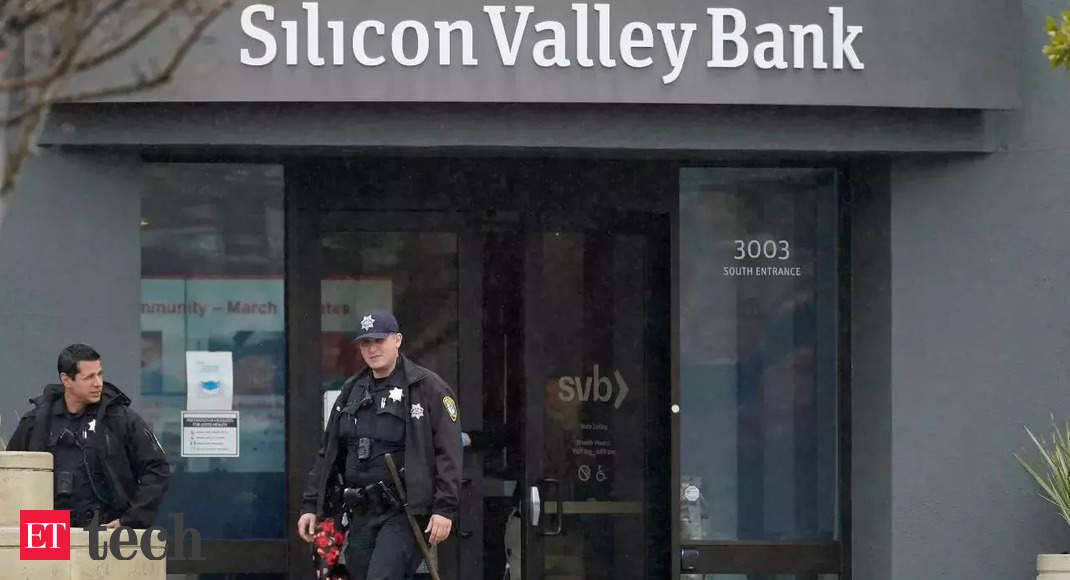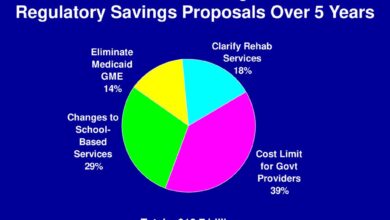
SVB Collapse Healthcare Sector Reels as Regulators Intervene
The fall of SVB hits healthcare sector as federal regulators step in – a headline that’s sent shockwaves through the industry. We’re talking about a seismic event, impacting everything from venture-backed startups scrambling for funding to established players facing unexpected financial strain. This isn’t just another financial crisis; it’s a direct hit to the very engine of healthcare innovation and access.
The ripple effects are already being felt, and the long-term consequences are still unfolding. This post dives into the immediate impacts, the federal response, and what this all means for the future of healthcare.
The immediate fallout saw a freeze on funding rounds for many healthcare companies, particularly those reliant on SVB for banking services. Venture-backed startups, biotech firms, and even some publicly traded companies found themselves suddenly grappling with cash flow issues. The federal government’s swift intervention, while crucial, also introduced a layer of uncertainty. The long-term effects on healthcare innovation, access, and affordability are still being assessed, but it’s clear that this crisis will reshape the landscape of healthcare finance for years to come.
We’ll explore the specifics, the potential solutions, and what this all means for patients and providers alike.
Immediate Impact on Healthcare Investments

Source: etimg.com
The collapse of Silicon Valley Bank (SVB) sent shockwaves through the financial world, and the healthcare sector, heavily reliant on venture capital and private equity, felt the impact acutely. The immediate market reaction was a mixture of uncertainty and panic, as investors grappled with the implications for their portfolios and the future of healthcare innovation. The ripple effect was felt across various segments of the industry, impacting both established players and burgeoning startups.The swiftness of the SVB failure amplified the existing anxieties within the healthcare investment landscape, already grappling with rising interest rates and a tightening funding environment.
The initial response was a freeze on new investments as investors assessed the extent of the damage and recalibrated their risk tolerance. This created a palpable sense of uncertainty, particularly for companies heavily reliant on SVB for banking services and funding.
Types of Healthcare Organizations Affected
The impact of the SVB collapse wasn’t uniform across the healthcare sector. Venture-backed startups, particularly those in early stages of development, were disproportionately affected due to their heavy reliance on venture capital funding often channeled through SVB. These companies often hold significant cash reserves in SVB, leaving them vulnerable to the bank’s failure. Publicly traded healthcare firms, while generally more resilient, also experienced market volatility and saw their stock prices decline in the aftermath of the collapse.
Larger, established companies with diversified funding sources were less directly impacted but still felt the indirect effects of the overall market downturn.
Short-Term Consequences for Healthcare Funding
The immediate consequence was a significant slowdown in funding rounds. Many venture capitalists adopted a wait-and-see approach, delaying investment decisions until the dust settled and the full extent of the fallout became clearer. This created a funding gap for many healthcare startups, forcing some to implement cost-cutting measures or even consider mergers or acquisitions to secure their survival. Future investments were also affected, with investors becoming more cautious and demanding higher returns in a riskier environment.
This could lead to a consolidation of the healthcare sector, with stronger companies acquiring weaker ones. The overall impact on innovation remains to be seen, as a potential reduction in funding could hinder the development of new therapies and technologies.
Impact Summary Table
| Organization Type | Investment Impact | Funding Status | Projected Recovery Time |
|---|---|---|---|
| Venture-backed Startups (Early Stage) | Significant negative impact; loss of funds, difficulty securing new funding | Many facing funding gaps; some seeking mergers/acquisitions | Variable; some may not recover; others may take 1-3 years |
| Venture-backed Startups (Later Stage) | Negative impact, but less severe than early-stage; access to alternative funding sources | Funding rounds delayed; some successful in securing alternative funding | 6 months to 2 years |
| Publicly Traded Firms | Stock price volatility; decreased investor confidence | Generally stable, but some may experience decreased valuations | 1-2 years |
| Large, Established Healthcare Companies | Minimal direct impact; indirect impact from market volatility | Stable funding; opportunities for acquisitions | Minimal impact; potentially faster recovery through acquisitions |
Federal Intervention and its Ripple Effects
Source: abcnewsfe.com
The collapse of Silicon Valley Bank (SVB) sent shockwaves through the financial system, and its impact on the healthcare sector, heavily reliant on venture capital and investment banking, was immediate and significant. Federal regulators swiftly intervened to prevent a wider systemic crisis, but the long-term consequences of their actions remain to be seen. This section delves into the specifics of the federal response, its potential ramifications for healthcare funding and innovation, and compares it to previous financial crises affecting the healthcare industry.The Federal Reserve, the FDIC, and the Treasury Department collaborated to implement a series of measures aimed at stabilizing the financial system and protecting depositors.
These actions included guaranteeing all deposits at SVB and Signature Bank, injecting liquidity into the banking system, and establishing a new lending facility to provide banks with access to short-term funding. While these measures prevented a complete meltdown, they also introduced significant costs and potential distortions to the market. The speed and decisiveness of the response, however, stand in stark contrast to the more hesitant approach seen during the 2008 financial crisis.
The collapse of SVB sent shockwaves through the healthcare sector, leaving many wondering about the future of funding and stability. This instability affects everyone, even those focused on critical issues like childhood development; for parents of children with Tourette Syndrome, finding effective management strategies is crucial, and resources like this guide on strategies to manage Tourette syndrome in children are invaluable.
The ripple effects of the SVB failure continue to impact healthcare access and funding, highlighting the need for resilient systems to support both immediate crises and long-term care needs.
Actions Taken by Federal Regulators
The federal government’s response involved several key actions. First, the FDIC stepped in to guarantee all deposits at SVB and Signature Bank, preventing a run on other institutions and protecting depositors. Second, the Federal Reserve provided liquidity support to banks through various lending facilities. This aimed to ensure banks had sufficient funds to meet their obligations and prevent further failures.
Third, the Treasury Department worked alongside the other agencies to coordinate the response and provide additional financial resources if needed. This coordinated effort was crucial in containing the crisis and minimizing its impact. For example, the speed with which the government acted prevented a domino effect that could have toppled other banks, a scenario that played out differently during the 2008 crisis.
Long-Term Consequences on Healthcare Funding and Innovation
The long-term consequences of the federal intervention remain uncertain. While the immediate crisis was averted, the government’s actions may have unintended consequences. For instance, the implicit government guarantee of deposits could lead to increased risk-taking by banks in the future, potentially destabilizing the financial system in the long run. Furthermore, the cost of the bailout will ultimately be borne by taxpayers, potentially impacting other government programs, including those related to healthcare.
The reduced availability of venture capital, a significant funding source for healthcare startups, could also hinder innovation in the sector. This could manifest in slower development of new treatments and technologies. A potential real-world example of this would be a delay in the development of cutting-edge cancer therapies due to decreased investment.
Comparison with Previous Financial Crises
The response to the SVB crisis differed significantly from the response to previous financial crises affecting the healthcare industry. During the 2008 financial crisis, the government’s response was slower and more hesitant, leading to a more prolonged and severe recession. The healthcare sector suffered from reduced investment and increased bankruptcies. In contrast, the swift and decisive action taken in response to the SVB crisis aimed to prevent a similar outcome.
The speed and scale of the intervention represent a shift in regulatory approach, reflecting lessons learned from past crises. The difference in response speed and scale between the two situations highlights the evolution of regulatory strategies in mitigating systemic risk.
Visual Representation of Federal Fund Distribution
Imagine a flowchart. At the top is a large box labeled “Federal Funds.” From this box, arrows branch out to smaller boxes representing various healthcare segments. One arrow leads to a box labeled “Hospitals,” another to “Biotechnology Firms,” another to “Pharmaceutical Companies,” and another to “Health Insurance Providers.” The thickness of each arrow could visually represent the proportion of funds allocated to each segment, illustrating the distribution of federal intervention across the healthcare ecosystem.
The relative thickness of arrows would demonstrate the differing degrees of impact and support provided by the federal intervention to each segment of the healthcare industry. This simplified model illustrates the flow of funds and their allocation across different healthcare sectors, highlighting the wide-ranging impact of the federal intervention.
Impact on Healthcare Technology and Innovation
The collapse of Silicon Valley Bank (SVB) sent shockwaves through the healthcare industry, particularly its vibrant technology sector. Many healthcare technology companies, especially startups and those reliant on venture capital funding, had significant deposits with SVB, leaving them vulnerable to the bank’s sudden failure. This financial instability created immediate liquidity issues and threatened the progress of innovative projects across various segments of the healthcare tech landscape.
The long-term effects on innovation and investment remain to be seen, but the initial impact has been substantial.The ripple effects of the SVB failure are far-reaching, impacting several key areas within healthcare technology. The disruption highlights the interconnectedness of the financial system and the delicate balance of funding for innovative ventures in this rapidly evolving sector. Understanding the challenges faced by these companies is crucial to assessing the overall impact on healthcare innovation.
Telehealth Companies Facing Funding Shortfalls
Several telehealth companies, heavily reliant on venture capital funding channeled through SVB, faced immediate liquidity challenges following the bank’s collapse. These companies, often operating on tight margins while scaling their operations, suddenly found their access to crucial operating capital severely restricted. This impacted their ability to pay salaries, maintain technological infrastructure, and continue expanding their services. For example, a hypothetical scenario could involve a promising telehealth startup specializing in remote patient monitoring for chronic conditions.
With a substantial portion of its operating funds held in SVB, the company faced immediate difficulties in paying its engineers and maintaining its cloud-based infrastructure, potentially leading to service disruptions and a slowdown in product development. The loss of funding could even force the company to downsize or, in the worst-case scenario, cease operations altogether.
Medical Device Startups Struggling with Development Costs
Medical device startups, often facing lengthy and expensive regulatory approval processes, are particularly vulnerable to financial instability. The substantial capital required for research, development, testing, and manufacturing makes them heavily reliant on consistent funding streams. The SVB collapse disrupted these funding flows, potentially delaying or halting the development of crucial new medical devices. Imagine a small medical device company developing a revolutionary minimally invasive surgical tool.
This company, heavily reliant on SVB for its operational funding, might face delays in clinical trials and regulatory submissions due to the sudden loss of access to capital. This delay could not only impact the company’s financial stability but also postpone the availability of a potentially life-saving technology to patients.
Pharmaceutical Companies and Clinical Trials
While larger pharmaceutical companies may have more diversified banking relationships, smaller biotech firms focused on drug discovery and development were also affected. Clinical trials are incredibly expensive, and disruptions to funding can lead to delays or cancellations, impacting the timeline for bringing potentially life-saving drugs to market. For instance, a small biotech company conducting phase III trials for a new cancer treatment might face delays due to funding shortages resulting from their exposure to SVB.
This could result in significant setbacks, not only for the company itself but also for patients awaiting access to this potentially groundbreaking treatment.
Strategies for Navigating Financial Instability
Healthcare technology companies need to adopt diversified funding strategies to mitigate future risks. This includes securing funding from multiple sources, including venture capital, private equity, strategic partnerships, and government grants. Diversification of banking relationships is also crucial to avoid over-reliance on a single financial institution. Furthermore, robust financial planning and stress testing are essential to anticipate and manage potential financial shocks.
Companies should also explore alternative financing options, such as revenue-based financing or debt financing, to supplement equity investments. Finally, focusing on operational efficiency and cost optimization can help companies navigate challenging financial climates.
Influence on Future Investment Decisions
The SVB collapse is likely to influence future investment decisions in healthcare technology. Investors may become more cautious and demand greater financial transparency and risk management from portfolio companies. This could lead to a more rigorous due diligence process and a greater emphasis on profitability and sustainability. Furthermore, the event might encourage greater diversification among investors, reducing reliance on any single funding source.
The collapse of SVB sent shockwaves through the financial system, and its impact on the healthcare sector is already being felt. This instability comes at a time when Medicare spending on GLP-1 medications for weight loss is exploding, as highlighted in this insightful KFF report: medicare glp1 spending weight loss kff. The uncertainty surrounding SVB’s fallout could further complicate already strained healthcare budgets and access to these and other vital medications.
The increased scrutiny could also potentially slow down the pace of investment in some areas, particularly in higher-risk, early-stage companies. However, it could also lead to a more mature and resilient healthcare technology ecosystem in the long run.
Long-Term Implications for Healthcare Access and Affordability: Fall Of Svb Hits Healthcare Sector As Federal Regulators Step In
Source: co.za
The collapse of Silicon Valley Bank (SVB) and its ripple effects through the healthcare sector present a serious threat to long-term healthcare access and affordability. The reduced investment capital and potential instability in the financial markets could significantly impact healthcare providers, particularly smaller organizations and those heavily reliant on venture capital, leading to consequences that will be felt by patients for years to come.
This instability could lead to reduced services, increased costs, and ultimately, decreased access to care, especially for vulnerable populations.
Reduced Funding and Healthcare Access for Vulnerable Populations
The SVB failure’s impact on healthcare funding could disproportionately affect vulnerable populations who already face barriers to accessing quality care. Reduced investment in community health centers, rural hospitals, and specialized clinics serving low-income individuals and underserved communities could lead to service cuts, longer wait times, and a decrease in the availability of essential healthcare services. For example, a reduction in funding for mental health services could exacerbate existing disparities in access to mental healthcare, potentially leading to worsened outcomes for individuals struggling with mental illness.
Similarly, cuts to preventative care programs could lead to higher rates of chronic disease and increased healthcare costs in the long run. This unequal impact underscores the urgency of addressing the long-term financial ramifications of the SVB crisis for vulnerable populations.
Affordability of Healthcare Services and Treatments
The SVB crisis could trigger a domino effect, leading to increased healthcare costs for everyone. Reduced investment in healthcare innovation may slow down the development of cost-effective treatments and technologies. Furthermore, decreased competition among healthcare providers due to mergers or closures resulting from financial instability could lead to higher prices for services. This is particularly concerning given the already high cost of healthcare in many countries.
For instance, if smaller hospitals are forced to consolidate or close due to funding issues, the remaining larger hospitals may have less incentive to keep prices competitive, potentially leaving patients with fewer choices and higher bills. The long-term consequences of this reduced competition could significantly impact the affordability of healthcare for individuals and families.
Influence on Healthcare Policy Decisions and Regulations
The SVB crisis is likely to prompt significant changes in healthcare policy and regulation. Governments may be forced to re-evaluate their reliance on private investment in the healthcare sector and consider alternative funding models. Increased scrutiny of financial regulations within the healthcare industry is also expected. This could lead to stricter oversight of healthcare investment funds and increased transparency in financial reporting.
The crisis might also accelerate the push for policies aimed at improving healthcare affordability and access, such as expanding public health insurance programs or implementing price controls on certain medical services. These policy adjustments will shape the future of healthcare financing and access for years to come.
Potential Policy Adjustments to Mitigate Negative Consequences
Addressing the long-term negative consequences of the SVB crisis requires a multifaceted approach. Potential policy adjustments include:
- Increased government funding for safety-net hospitals and community health centers to ensure continued access to care for vulnerable populations.
- Expansion of public health insurance programs to broaden coverage and reduce the financial burden on individuals and families.
- Implementation of stricter regulations on healthcare investment funds to prevent future financial crises.
- Incentivizing the development and adoption of cost-effective healthcare technologies and treatments.
- Promoting greater transparency and competition within the healthcare industry to curb rising costs.
The Role of Venture Capital and Private Equity in Healthcare
The collapse of Silicon Valley Bank (SVB) sent shockwaves through the financial system, and its impact on the healthcare sector, heavily reliant on venture capital (VC) and private equity (PE) funding, is particularly noteworthy. Before the crisis, these firms played a crucial role in fueling innovation, providing capital for startups developing new drugs, medical devices, and digital health solutions.
The SVB situation, however, forced a reevaluation of funding strategies and risk assessment within the healthcare investment landscape.Venture capital and private equity firms have historically been key players in financing healthcare innovation. They provided crucial seed funding, Series A and B rounds, and later-stage investments for companies across the healthcare spectrum. This funding allowed promising technologies and treatments to progress through clinical trials, gain regulatory approvals, and ultimately reach patients.
However, the concentration of these investments within SVB exposed the fragility of this ecosystem.
Venture Capital Investment Strategies Post-SVB Collapse
The SVB collapse forced a swift reassessment of risk management among VC and PE firms. Many firms experienced significant losses due to their deposits in SVB, impacting their ability to deploy capital. This led to a more cautious investment approach, with a greater emphasis on due diligence and a focus on companies with strong balance sheets and diverse funding sources.
Some firms began diversifying their banking relationships, spreading their deposits across multiple institutions to mitigate future risks. Others focused on later-stage investments, where companies had already secured significant funding and demonstrated greater resilience. For example, firms like Andreessen Horowitz, known for their early-stage investments, may have shifted to later-stage funding or focused on companies with established revenue streams.
Conversely, firms specializing in later-stage investments might have become more selective in their deals, focusing on companies with proven track records and less reliance on external funding.
Reshaping the Venture Capital Landscape in Healthcare
The SVB failure highlighted the interconnectedness of the healthcare investment ecosystem. The sudden loss of access to capital created a liquidity crunch, particularly for early-stage companies relying heavily on SVB for funding. This led to a slowdown in deal flow and a decrease in valuations for some healthcare startups. Some companies were forced to cut costs, delay clinical trials, or even seek alternative funding sources.
The SVB collapse sent shockwaves through the healthcare sector, leaving many wondering about the financial stability of related companies. It’s a tough time, and understanding the financial health of major players like Elevance Health is crucial; check out their Q1 earnings report, which discusses the impact of a recent cyberattack and changes in Medicaid and Medicare Advantage participation, here.
The fallout from the SVB situation and the broader economic uncertainty are definitely factors to consider in this already complex landscape.
The long-term consequences remain to be seen, but the crisis is likely to lead to a more diversified and potentially less risky investment landscape. This could involve a greater reliance on strategic partnerships, corporate venture capital, and government grants.
Alternative Funding Sources for Healthcare, Fall of svb hits healthcare sector as federal regulators step in
The SVB collapse accelerated the exploration of alternative funding sources for healthcare companies. This includes an increased focus on corporate venture capital arms of large pharmaceutical and medical device companies. These corporations often seek strategic investments in startups that complement their existing portfolios or offer access to innovative technologies. Government grants and other public funding programs also play a larger role, particularly for research and development in areas of public health importance.
Crowdfunding platforms are another potential avenue, allowing startups to tap into a broader pool of investors. While these alternatives offer potential, they also come with their own limitations, such as stringent regulatory requirements and potentially lower investment amounts compared to traditional VC and PE funding. The success of these alternatives will depend on their ability to fill the funding gap left by the SVB collapse and adapt to the evolving needs of healthcare startups.
Epilogue
The collapse of Silicon Valley Bank has undeniably shaken the healthcare sector to its core. While the immediate crisis has been somewhat contained by federal intervention, the lingering effects on funding, innovation, and access to care are significant and far-reaching. The future of healthcare finance is undeniably uncertain, but understanding the complexities of this crisis is the first step towards navigating the challenges ahead.
We need to closely monitor the evolving situation, advocate for policy changes that protect vulnerable populations, and explore alternative funding models to ensure the continued growth and accessibility of healthcare for everyone.
FAQ
What types of healthcare organizations were most affected by the SVB collapse?
Venture-backed startups, particularly in biotech and medical technology, were disproportionately affected, along with smaller community hospitals and clinics who banked with SVB.
Will this affect my healthcare costs?
Potentially, yes. Reduced funding for healthcare providers could lead to increased costs or reduced services in the long run, especially for vulnerable populations.
What are the long-term implications for healthcare innovation?
The crisis could stifle innovation by limiting access to capital for startups and potentially slowing down the development of new treatments and technologies.
What is the government doing to address the situation?
The government implemented measures to guarantee deposits at SVB and other failing banks, aiming to prevent a wider financial crisis and stabilize the healthcare sector.




